Many types of brown spiders can be found in Tennessee. While these spiders may look terrifying with their lanky legs and hairy bodies, these arachnids actually benefit the environment. Brown spiders help control populations of other insects, which, in turn, helps keep the ecosystem balanced. Spiders are also an important food source for other animals, such as birds and lizards. Overall, brown spiders can be helpful creatures that play an essential role in the ecosystem. So, it is important to be respectful of them, but with that said, some of these brown spiders can be dangerous so it’s vital to take precautions if necessary.
Whether you’re curious to identify the brown spiders in and around your home or simply want to learn about these fascinating creatures, here are some brown spiders commonly found in Tennessee.
Southern House Spider (Kukulcania hibernalis)
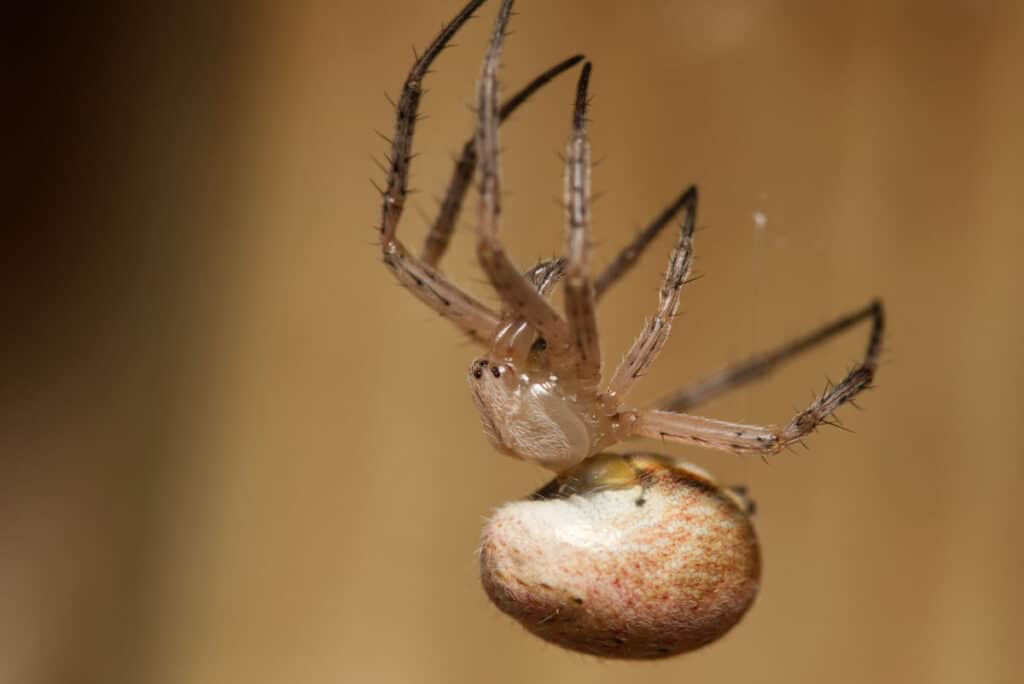
©Kala Stuwe/Shutterstock.com
The southern house spider is one of the most common spiders in Tennessee. They are brown, black, or gray in color and have a mottled appearance. Southern house spiders are not aggressive and will only bite if they feel threatened. Their venom is not harmful to humans, but it can cause localized swelling and pain. These spiders typically build their webs in dark, undisturbed areas like basements, closets, and attics. They primarily feed on insects that become caught in their intricate webs.
While these spiders may look similar to the dangerous brown recluse spiders you may also come across in Tennessee, southern house spiders are not venomous. They are shy spiders, so they won’t generally attack humans, but if you are bitten, there is no need to worry.
Brown Recluse Spider (Loxosceles reclusa)
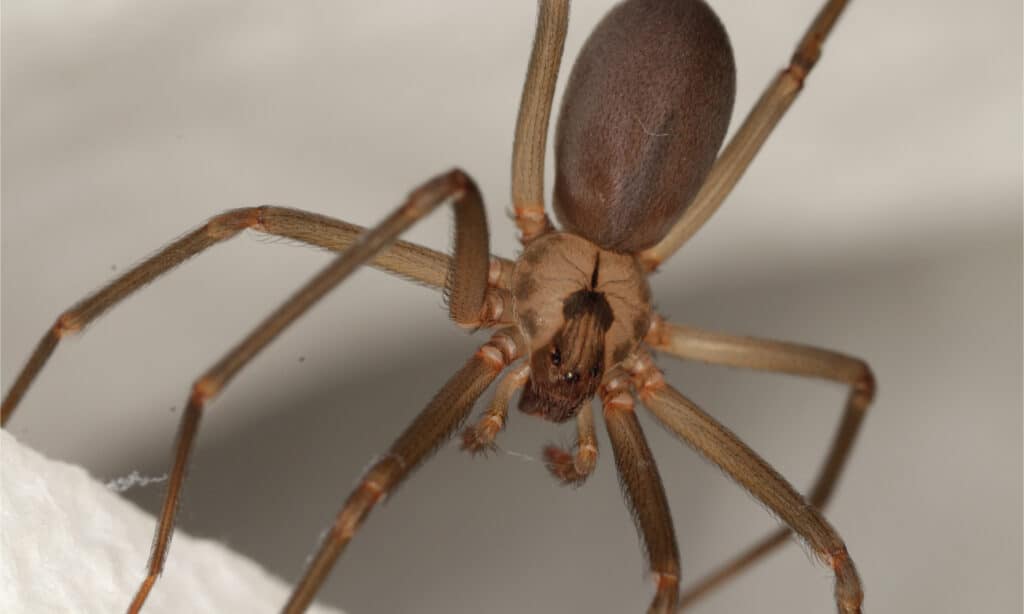
©Nick626/Shutterstock.com
The brown recluse spider is found in Tennesse, although it is a less common sight than other spiders. They get their name from their shy nature – these spiders prefer to avoid contact with humans whenever possible. However, if they feel threatened, they will bite – and their venom can be quite dangerous to humans, leading to serious health complications. Brown recluse spiders are light brown, dark colored, or tan with a dark violin-shaped marking on their back (hence another one of their nicknames – the fiddle-back spider). These spiders typically build their webs in dark corners or under furniture where there is little disturbance from humans or other animals.
The brown recluse spider is one of the more venomous spiders in Tennessee. But thankfully, while incredibly toxic, this spider does not inject enough venom to cause humans too much harm. If bitten, expect skin damage, pain, and muscle aches. You should seek medical attention immediately if you suspect to have been bitten by a brown recluse spider.
Long-Bodied Cellar Spider (Pholcus phalangioides)
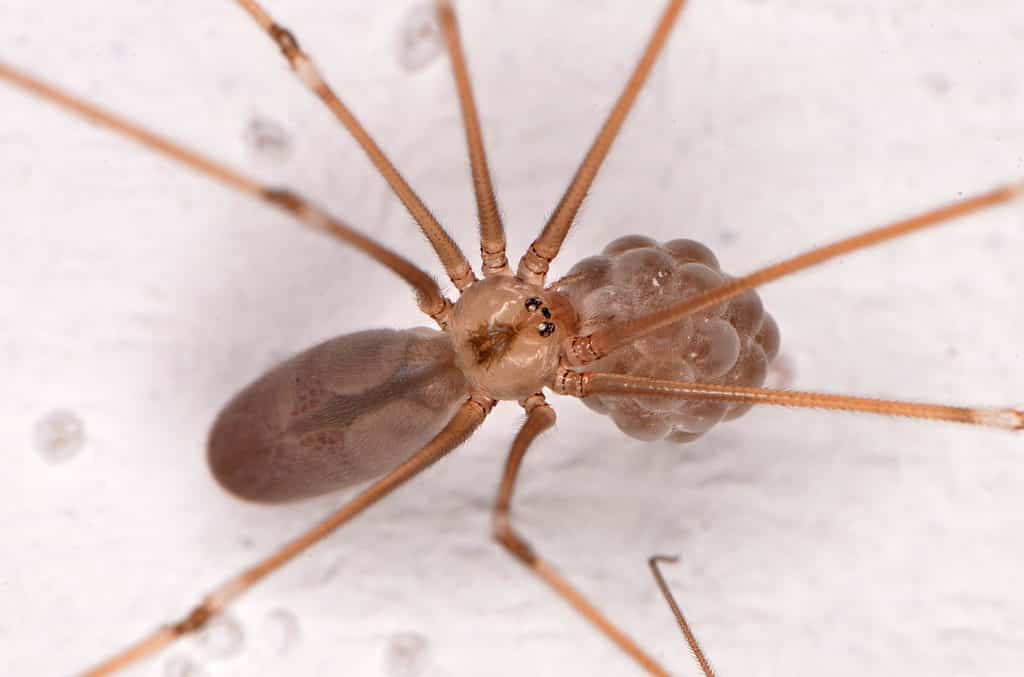
©Marek Velechovsky/Shutterstock.com
Cellar spiders are long-legged spiders with bodies that range in size from 6 to 10 mm. You may also know them by their more common name: daddy long legs. These spiders vary in color but are typically light brown or gray. They have long, thin legs, and their abdomens are oval-shaped. Cellar spiders feed primarily on insects and other small arthropods. They will also occasionally eat small vertebrates, such as frogs or lizards.
Cellar spiders are found in various habitats, including basements, caves, and cellars, hence their name. They often build their webs in corners or between beams. These spiders are nocturnal hunters that wait for prey to become entangled in their webs. Once captured, the spider will wrap the target in silk and then bite it to paralyze it before eating it. Cellar spiders are also known for their ability to vibrate their webs rapidly when disturbed, which helps them escape predators or potential threats.
Although they have venom glands that they use to kill their prey, the cellar spider’s venom is not considered harmful to humans unless injected directly into the bloodstream, which is very unlikely to happen. However, some may experience allergic reactions to the venom if bitten.
Ravine Trapdoor Spider (Cyclocosmia truncata)
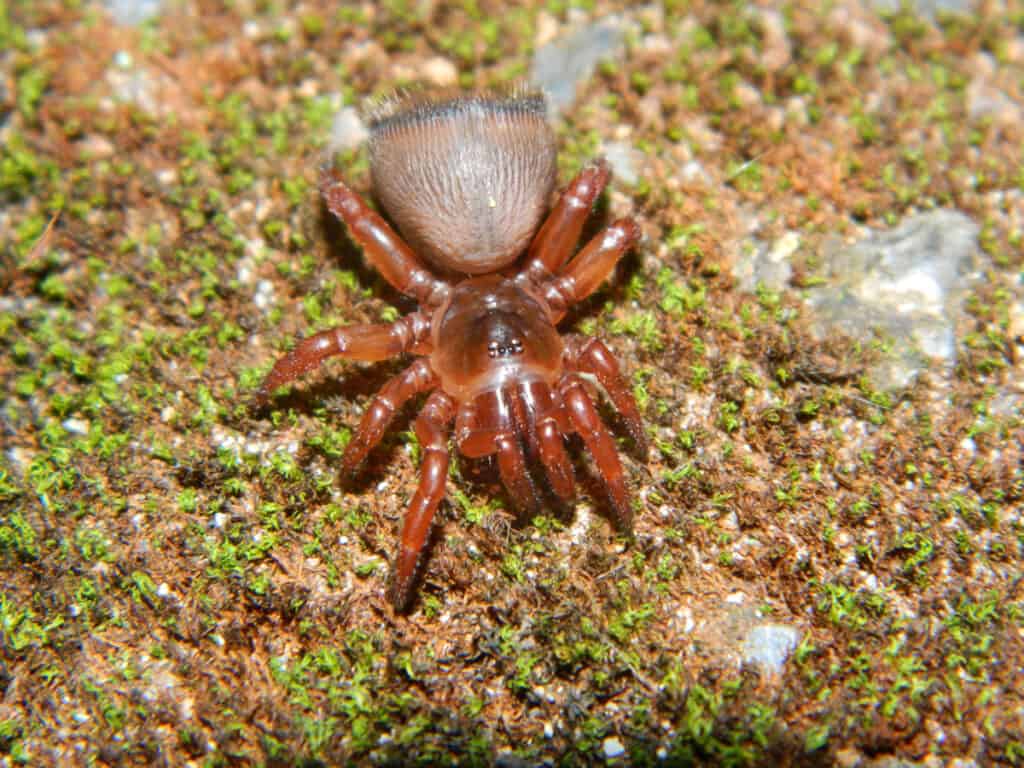
©Venus Saksongmuang/Shutterstock.com
The ravine trapdoor spider is a medium-sized spider. They are dark brown or black, and their bodies are covered in short hair. They have two large chelicerae (jaws) and four pairs of legs. Their abdomens are oval-shaped and have a small bump on their backs where their spinnerets are located.
This spider is found in various habitats, including woodlands, forests, grasslands, and deserts. They build burrows in the ground that they line with silk. These burrows can be up to 2 feet deep in some cases. The trapdoor at the burrow’s entrance helps the spider ambush unsuspecting prey.
The trapdoor spider is a nocturnal creature that is most active at night. During the day, they remain hidden inside their burrows with closed doors. When night falls, they open the door slightly and wait for prey to pass before pouncing on them. If they feel threatened, they will quickly close the door to their burrow and hide until it is safe to come out again.
The venom of the trapdoor spider is not considered dangerous to humans unless you are allergic to it. However, it is powerful enough to kill their insect prey instantly. The lifespan of a trapdoor spider can be up to 10 years in captivity. In the wild, however, they only live for around two to three years, mainly due in part to predation from other animals, such as lizards or birds.
Giant Lichen Orb-Weaver Spider (Araneus bicentenarius)
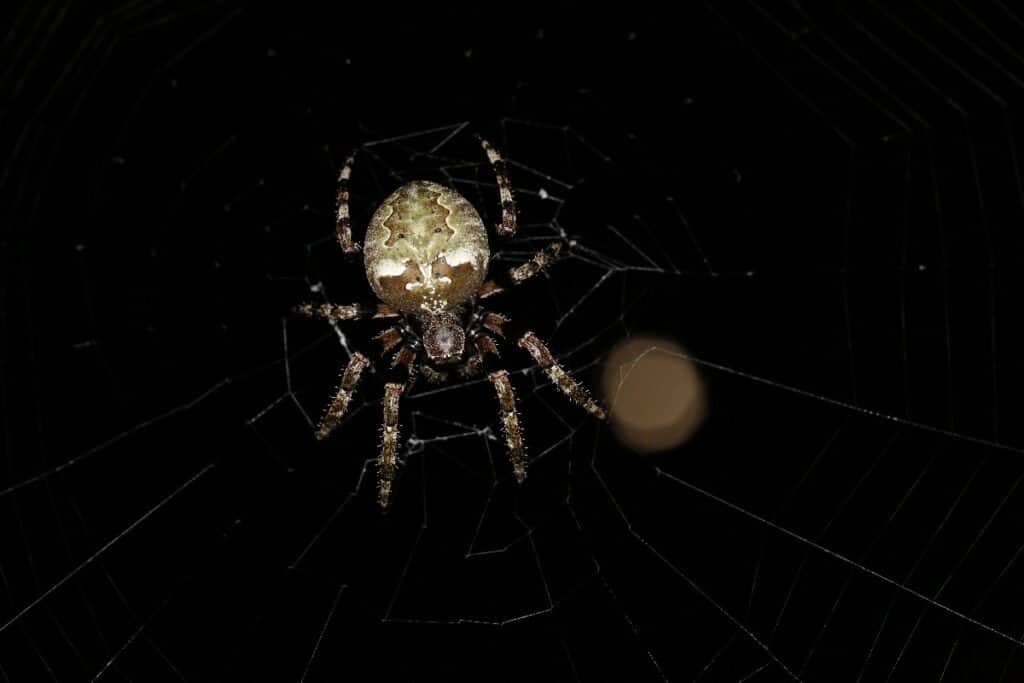
©Cathleen Wake Gorbatenko/Shutterstock.com
Found in woodlands, fields, and gardens across North America, giant lichen orb-weaver spiders can be, as their name suggests, giant! They have a body length of approximately 1.5 inches and a leg span of up to 4 inches. Females can live for up to two years, while males only live for around one year. These spiders are brown or gray in color, with white spots on their abdomens.
Giant lichen orb-weaver spiders prey upon insects such as flies, mosquitoes, and moths. They build large webs in trees and bushes and wait patiently for their prey to become entangled. Once their prey is caught, the spider quickly wraps it in silk and paralyzes it with venom, before devouring it.
These spiders are not dangerous to humans, as their venom is not strong enough to cause serious harm. However, they can deliver a painful bite if they feel threatened. Therefore, if you come across one of these spiders, it is best to leave them alone and give them space.
European Garden Spider (Araneus bicentenarius)

©/Shutterstock.com
European garden spiders are easily recognizable by their large, round abdomens, and distinctive cross-shaped markings. They are usually brown or gray in color, with adults ranging in size from approximately 0.2 to 0.8 inches or 5 to 20 mm. European garden spiders are found throughout Europe and Asia and have also been introduced to North America.
These spiders are generalist predators, meaning they eat just about anything they can catch. Their diet consists of insects and other small arthropods, but they have been found to eat small vertebrates like lizards and frogs occasionally.
European garden spiders build large, intricate webs in gardens, fields, and forests. The webs can be up to 2 meters in diameter. These spiders are not aggressive and will not bite humans unless they feel threatened. Their venom only causes mild irritation at the bite site.
Running Crab Spider (Philodromus cespitum)
Running crab spiders are small in size (around 0.2 inches or 5 mm) and vary in color depending on their species and location. They are typically brown or gray, with darker markings on their abdomens. Some species of running crab spiders can also be brightly colored, like orange or yellow.
These spiders can easily blend into their surroundings, making them difficult for predators (and humans) to spot. Their diet consists mainly of insects, which they hunt and capture using quick reflexes. They are known to be particularly effective at hunting flying insects, like bees and flies.
Running crab spiders are found worldwide in various habitats, including forests, grasslands, gardens, and even inside homes. They are often seen running along walls or ceilings in search of prey.
These spiders’ venom is not strong enough to cause serious harm. However, it can still cause mild discomfort.
Furrow Orb-Weaver Spider (Larinioides cornutus)
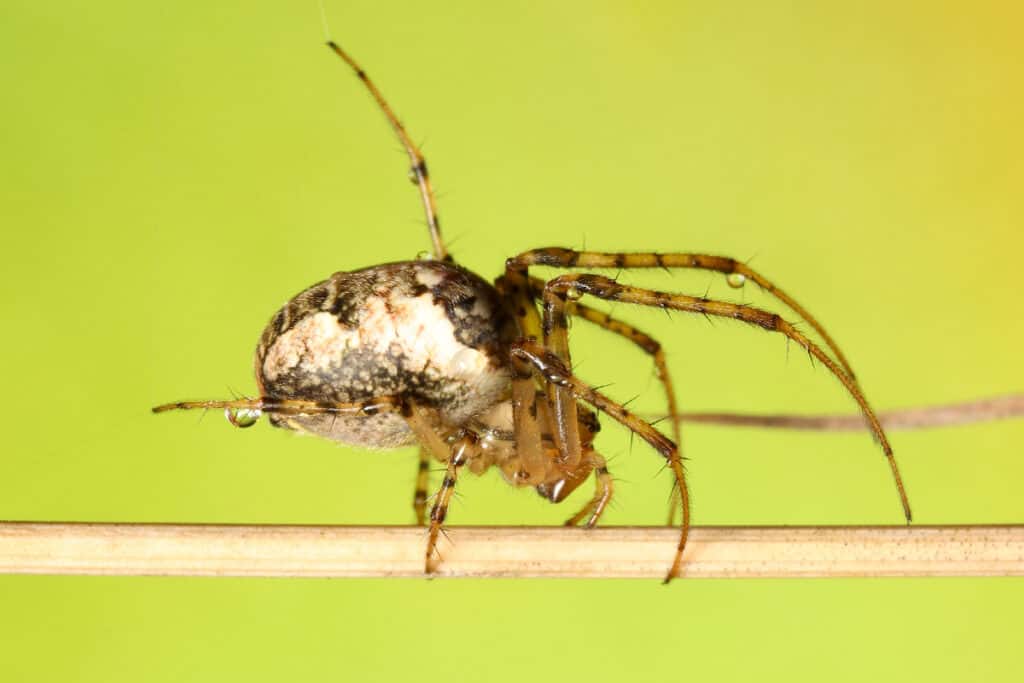
©iStock.com/Dan Olsen
The furrow orb-weaver spider is found in Europe and North America, including in Tennessee. They are also sometimes referred to as the cornutus spider. These spiders get their name from the furrows on their carapace (the hard outer shell of their body).
Furrow spiders are brown or black and measure approximately 0.2 to 0.55 inches (5 to 14 mm) in length, with males on the smaller side. They have long legs and are known for being good jumpers.
These spiders typically live in areas with high vegetation, such as gardens, fields, and forests. They build their webs close to the ground and use them to capture prey such as insects and small rodents.
Their venom is not considered harmful to humans; however, they can give a painful bite. Furrow orb-weaver spiders are generally shy creatures that will only bite humans if they feel provoked or threatened. If you come across one of these spiders, it is best to leave them alone.
Banana Spider (Trichonephila clavipes)
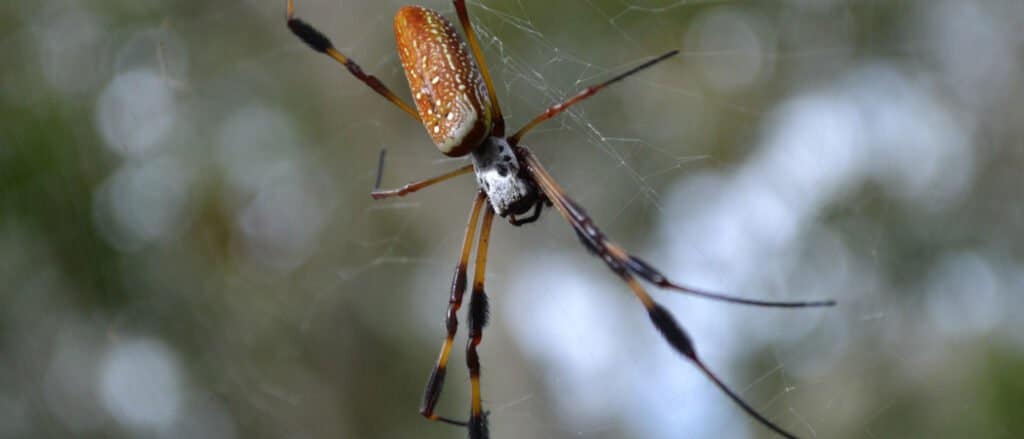
©Natalie Gail/Shutterstock.com
The golden silk orb-weaver spider is commonly called the banana spider. Females of this large species can grow up to approximately 1.5 inches in body length alone, with long legs extending from their abdomen. In other words, they are huge! Their bodies are typically yellowish-brown or orange. They have orange and black striped legs that are covered in tiny hairs.
These spiders typically live in rainforests or other humid environments. They build large webs in trees or other high places, which they sometimes share with multiple spiders of the same species. Happening upon a massive web occupied by several banana spiders can be intimidating, indeed! Banana spiders mostly eat insects, but they will also occasionally eat small mammals or reptiles. When it comes to behavior, banana spiders are relatively docile creatures. However, they will become aggressive if they feel threatened.
Banana spiders are venomous, but their venom is not harmful to humans. With that said, if you come across one of these spiders in the wild, it is best to admire it from afar.
American Grass Spider (Agelenopsis)
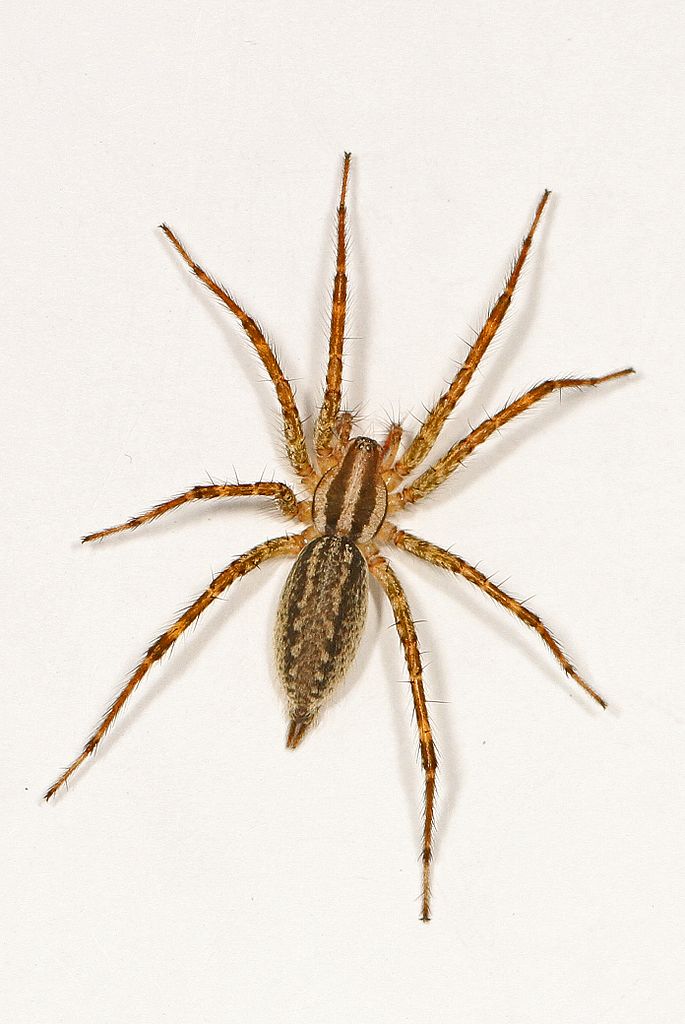
©Judy Gallagher / flickr – License
The American grass spider is a tiny to medium-sized spider that can range in color from light brown to dark brown. Males and females can look very similar, but males are usually smaller. The American grass spider is found throughout many places in the United States, including Tennessee. These spiders prefer grassy habitats with plenty of vegetation to build their webs in.
The American grass spider preys on small insects and other arthropods. They build webs near the ground to capture their prey. Some consider this spider one of the most efficient hunters among all spider species. They spin silken tripwires and sticky spirals in their webs to capture prey that might otherwise escape their webs.
Like many other spiders, the American grass spider is not generally aggressive and will only bite if provoked. Sometimes, if they feel cornered, they will drop off their web and play dead until the threat has passed.
The American grass spider’s venom is not harmful to humans but can be irritating.
Brown Widow Spider (Latrodectus geometricus)
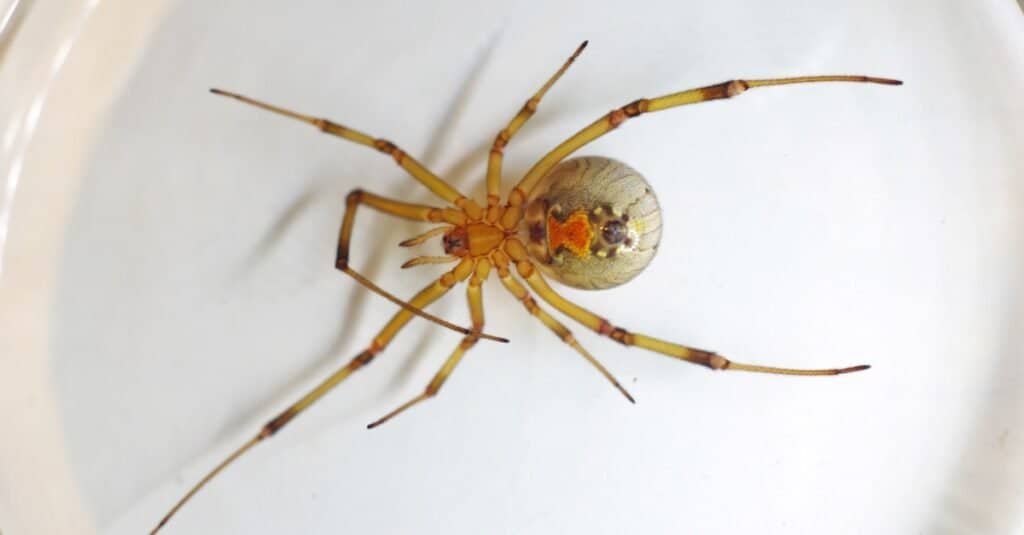
©Decha Thapanya/Shutterstock.com
The brown widow spider is found in many different tropical and sub-tropical parts of the world. As evidenced by its name, it is brown in color and a cousin to the famous black widow spider. Unlike its famous relative, it does not have a striking red mark on its body; rather, this spider has a mottling of tan and brown with some black markings, making it less conspicuous.
Brown widow spiders mainly eat insects, like flies and moths. And they like to set up their base in secluded vegetation or dark areas in a home, including in garages, underneath chairs, and in and around abandoned cars. Since the brown widow tends to choose places that are more exposed, you’re more likely to get bitten by a brown widow than a black widow.
The brown widow spider is not aggressive, but if it is trapped, it will bite. The venom of this spider can be very dangerous to humans and even fatal in some cases, so it is best to learn to identify the brown widow and keep your distance. With that said, the bite of a brown widow spider is not as dangerous as that of a black widow.
Up Next
The post Discover 11 Brown Spiders in Tennessee appeared first on AZ Animals.
from Animal News, Facts, Rankings, and More! - AZ Animals https://ift.tt/e70WJ3b